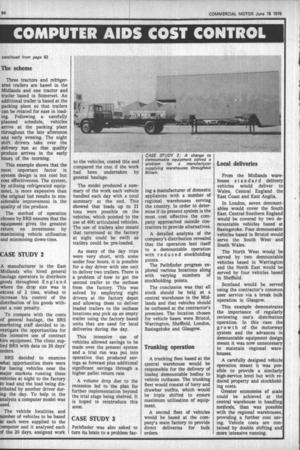COMPUTER AIDS COST CONTROL
Page 96

If you've noticed an error in this article please click here to report it so we can fix it.
continued from page 93
The scheme
Three tractors and refrigerated trailers are based in the Midlands and one tractor and trailer based in Somerset. An additional trailer is based at the packing plant so that trailers can be rotated for ease in loading. Following a carefully planned schedule, vehicles arrive at the packing plant throughout the late afternoon and early evening. The night shift drivers take over the delivery run so that quality produce arrives in the early hours of the morning.
This example shows that the most important factor in system design is not cost but cost effectiveness. The system, by utilising refrigerated equipment, is more expensive than the original but results in considerable improvement in the quality of the produce.
The method of operation chosen by BRS ensures that the equipment gives the greatest return on investment by maximising vehicle utilisation and minimising down-time.
CASE STUDY 2
A manufacturer in the East Midlands who hired general haulage operators to distribute goods throughout England where the drop size was in excess of 2 tons, wished to increase his control of the distribution of his goods without a cost penalty.
To compete with the costs of general haulage, the BRS marketing staff decided to investigate the opportunities for the intensive use of contract hire equipment. The client suplied BRS with data on 20 days' orders.
BRS decided to examine what opportunities there were for basing vehicles near the major markets running these vehicles at night to the factory to load and the load being distributed by another driver during the day. To help in the analysis a computer model was used.
The vehicle localities and number of vehicles to be based at each were supplied to the computer and it analysed each of the 20 days, assigned work to the vehicles, costed this and compared the cost if the work had been undertaken by general haulage.
The model produced a summary of the work each vehicle handled each day with a total summary at the end. This showed that loads up to 21 tons were possible on the vehicles, which pointed to the use of 40ft articulated vehicles. The use of trailers also meant that turnround at the factory at night could be swift as trailers could be pre-loaded.
As many of the day trips were very short, with some under four hours, it is possible for a day driver with one unit to deliver two trailers. There is a problem of how to get the second trailer to the outbase from the factory. This was solved by employing night drivers at the factory depot and allowing them to deliver loaded trailers to the outbase locations and pick up an empty trailer using the factory based units that are used for local deliveries during the day.
This intensive use of vehicles allowed savings to be made over the present system and a trial run was put into operation that produced savings as forecast plus additional significant savings through a higher pallet return rate A volume drop due to the recession led to the plan for further implementation beyond the trial stage being shelved. It is hoped to reintroduce this soon.
CASE STUDY 3
Pathfinder was also asked to turn its brain to a problem fac ing a manufacturer of domestic appliances with a number of regional warehouses serving the country. In order to determine if its present system is the most cost effective the company approached outside contractors to provide alternatives.
A detailed analysis of the company's distribution revealed that the operation lent itself to a demountable operation with reduced stockholding points.
The Pathfinder program explored various locations along with varying numbers of stockholding points.
The conclusion was that all stock should be held at a central warehouse in the Midlands and that vehicles should be outbased at the contractor's premises. The location chosen for vehicle bases were Bristol, Warrington, Sheffield, London, Basingstoke and Glasgow.
Trunking operation
A trunking fleet based at the central warehouse would be responsible for the delivery of loaded demountable bodies to vehicle outbases. The trunking fleet would consist of lorry and drawbar outfits, which would be triple shifted to ensure maximum utilisation of equipment.
A second fleet of vehicles would be based at the company's main factory to provide direct deliveries for bulk orders From the Midlands warehouse standard delivery vehicles would deliver to Wales, Central England the East Coast and East Anglia, In London, seven demountables would cover the South East. Central Southern England would be covered by two demountable vehicles based at Basingstoke. Four demountable vehicles based in Bristol would serve the South West and South Wales.
The North West would be served by two demountable vehicles based in Warrington and the North East would be served by four vehicles based in Sheffield.
Scotland would be served using the contractor's common user service via a break bulk operation in Glasgow.
This example demonstrates the importance of regularly reviewing one's distribution operation. In this case the growth of the motorway system and the advances in demountable equipment design meant it was now unnecessary to maintain regional warehouses.
A carefully designed vehicle operation meant it was possible to provide a similarly high-service level but with reduced property and stockholding costs.
Greater economies of scale could be achieved at the central warehouse in handling methods, than was possible with the regional warehouses, providing a further cost saving. Vehicle costs are contained by double shifting and more intensive running.












































































































































































